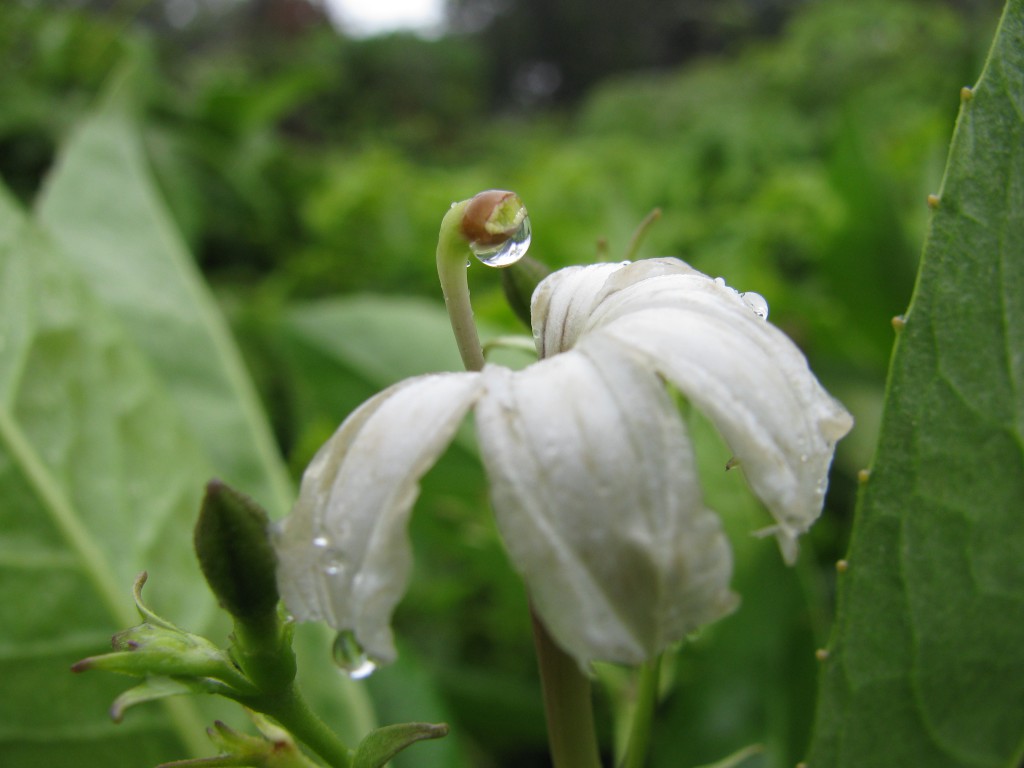Rain Forest » Unit 1: Why Is The Rain Forest Wet?
Overview
Water, of course, is one of the defining features of the rain forest environment. Rain forest plants and animals are adapted to living with high levels of rainfall and humidity year-round. And from the rain forest of East Maui comes the water supply for much of Upcountry, Central, and East Maui. In this unit, students examine rainfall patterns and their causes in the rain forest zone of windward Haleakalā and explore the rain forest as a source of water for human use.
Length of Entire Unit
Five class periods.
Subject
Climate of the rain forest. The relationship between rainfall, intact rain forest, and human water supply.
Importance
Climate is a key factor in shaping the environmental conditions of the rain forest. Water is one of the defining features of the rain forest, with high levels of rainfall and humidity the norm year-round. And the rain that falls on the rain forest is also an important source of water for human use.
Unit Focus Questions
- How are climate and weather important in traditional Hawaiian culture?
- What climatic forces influence the location of the rain forest on Haleakalā?
- What are the environmental conditions for plants and animals in the rain forest?
- How does the native Haleakalā rain forest protect the water supply for much of East, Central, and Upcountry Maui?
- What effects do changes in the structure of the rain forest have on the function of the watershed?
Enrichment Ideas
- Find out where the water students drink at home comes from. How about at school? Research local issues related to water consumption. Look in local newspapers for stories related to water supply or water use.
- Write a paper about how altering the rain forest would likely affect human water supply or the impacts the loss of forests on Maui has already had on rainfall and human water supply.
- Find Hawaiian chants or hula about the Hāna, Kīpahulu, or Koʻolau areas, or about other parts of the rain forest on Haleakalā. Or create original chants and dance based on the information learned in this unit.
- Research the East Maui Watershed (which covers the whole windward side of Haleakalā). It is the single largest source of harvested surface water in the state. East Maui supplies drinking water to Upcountry and East Maui, and irrigation water to the Hawaiian Commercial & Sugar Company in Central Maui.
- One place to start looking for information—and another research topic in itself—is the East Maui Watershed Partnership. The partnership is a collaborative effort among six public and private landowners and Maui County to protect the 100,000-acre rain forest core of this critical watershed. Online information about the partnership can be found at their website. Students may also want to contact the major partners directly: The Nature Conservancy, East Maui Irrigation Company, Hawaiʻi Department of Land and Natural Resources, National Park Service, Haleakalā Ranch, Hāna Ranch, and Maui County.
- Instead of doing the condensation demonstration in Activity #2, have students do it as a lab.
Resources for Further Reading
Giambelluca, Thomas, and Marie Sanderson, “The Water Balance and Climatic Classification,” in Marie Sanderson (ed.), Prevailing Trade Winds: Weather and Climate in Hawaiʻi, University of Hawaiʻi Press, Honolulu, 1993, pp. 56-72.
Juvik, S. P., and J. O. Juvik, Atlas of Hawaiʻi, third edition, University of Hawaiʻi Press, Honolulu, 1998. (Page 59 provides general background about rainfall on the Hawaiian Islands.)
Juvik, J. O., and D. Nullet, “Relationships Between Rainfall, Cloud-Water Interception, and Canopy Throughfall in a Hawaiian Montane Forest,” in Hamilton, L. S., J. O. Juvik, and F. N. Scatena (eds.), Tropical Montane Cloud Forests, New York, Springer-Verlag, 1995, pp. 165-182.
Kert, Harold Winfield, Treasury of Hawaiian Words in One Hundred and One Categories, Masonic Public Library of Hawaiʻi, Honolulu, 1986.
Loope, Lloyd L., and Thomas W. Giambelluca, “Vulnerability of Island Tropical Montane Cloud Forests to Climate Change, with Special Reference to East Maui, Hawaii,” Climatic Change, Vol. 39, 1998, pp. 503-517. (Although this article focuses on the potential effects of climate change, it provides excellent background on the characteristics of the cloud forest climate on Haleakalā, as well as several points of comparison between the windward and leeward side climate.)
Maui Department of Water Supply at their website.
Pukui, Mary Kawena, Samuel H. Elbert, and Esther T. Mookini, Place Names of Hawaiʻi, University of Hawaiʻi Press, Honolulu, 1974.
Shade, P. J., Water Budget of East Maui, Hawaiʻi, U.S. Geological Survey, Honolulu, 1999.




